TNF-α impairs EP4 signaling through the association of TRAF2-GRK2 in primary fibroblast-like synoviocytes
- PMID: 33859345
- PMCID: PMC8791952
- DOI: 10.1038/s41401-021-00654-z
TNF-α impairs EP4 signaling through the association of TRAF2-GRK2 in primary fibroblast-like synoviocytes
Abstract
Our previous study showed that chronic treatment with tumor necrosis factor-α (TNF-α) decreased cAMP concentration in fibroblast-like synoviocytes (FLSs) of collagen-induced arthritis (CIA) rats. In this study we investigated how TNF-α impairs cAMP homeostasis, particularly clarifying the potential downstream molecules of TNF-α and prostaglandin receptor 4 (EP4) signaling that would interact with each other. Using a cAMP FRET biosensor PM-ICUE3, we demonstrated that TNF-α (20 ng/mL) blocked ONO-4819-triggered EP4 signaling, but not Butaprost-triggered EP2 signaling in normal rat FLSs. We showed that TNF-α (0.02-20 ng/mL) dose-dependently reduced EP4 membrane distribution in normal rat FLS. TNF-α significantly increased TNF receptor 2 (TNFR2) expression and stimulated proliferation in human FLS (hFLS) via ecruiting TNF receptor-associated factor 2 (TRAF2) to cell membrane. More interestingly, we revealed that TRAF2 interacted with G protein-coupled receptor kinase (GRK2) in the cytoplasm of primary hFLS and helped to bring GRK2 to cell membrane in response of TNF-α stimulation, the complex of TRAF2 and GRK2 then separated on the membrane, and translocated GRK2 induced the desensitization and internalization of EP4, leading to reduced production of intracellular cAMP. Silencing of TRAF2 by siRNA substantially diminished TRAF2-GRK2 interaction, blocked the translocation of GRK2, and resulted in upregulated expression of membrane EP4 and intracellular cAMP. In CIA rats, administration of paroxetine to inhibit GRK2 effectively improved the symptoms and clinic parameters with significantly reduced joint synovium inflammation and bone destruction. These results elucidate a novel form of cross-talk between TNFR (a cytokine receptor) and EP4 (a typical G protein-coupled receptor) signaling pathways. The interaction between TRAF2 and GRK2 may become a potential new drug target for the treatment of inflammatory diseases.
Keywords: EP4; GRK2; TNFR2; TRAF2; fibroblast-like synoviocytes; rheumatoid arthritis.
© 2021. The Author(s), under exclusive licence to CPS and SIMM.
Conflict of interest statement
The authors declare no competing interests.
Figures








Similar articles
-
The intersection of GRK2 and PGE2 in rheumatoid arthritis: a comprehensive update on pathophysiology and treatment.Naunyn Schmiedebergs Arch Pharmacol. 2025 Apr 22. doi: 10.1007/s00210-025-04163-2. Online ahead of print. Naunyn Schmiedebergs Arch Pharmacol. 2025. PMID: 40261352 Review.
-
CP-25 reverses prostaglandin E4 receptor desensitization-induced fibroblast-like synoviocyte dysfunction via the G protein-coupled receptor kinase 2 in autoimmune arthritis.Acta Pharmacol Sin. 2019 Aug;40(8):1029-1039. doi: 10.1038/s41401-018-0196-2. Epub 2019 Jan 14. Acta Pharmacol Sin. 2019. PMID: 30643209 Free PMC article.
-
GRK2 Mediated Abnormal Transduction of PGE2-EP4-cAMP-CREB Signaling Induces the Imbalance of Macrophages Polarization in Collagen-Induced Arthritis Mice.Cells. 2019 Dec 8;8(12):1596. doi: 10.3390/cells8121596. Cells. 2019. PMID: 31818003 Free PMC article.
-
Paeoniflorin inhibits proliferation of fibroblast-like synoviocytes through suppressing G-protein-coupled receptor kinase 2.Planta Med. 2012 May;78(7):665-71. doi: 10.1055/s-0031-1298327. Epub 2012 Mar 12. Planta Med. 2012. PMID: 22411721
-
TRAF2 multitasking in TNF receptor-induced signaling to NF-κB, MAP kinases and cell death.Biochem Pharmacol. 2016 Sep 15;116:1-10. doi: 10.1016/j.bcp.2016.03.009. Epub 2016 Mar 16. Biochem Pharmacol. 2016. PMID: 26993379 Review.
Cited by
-
TRAF2 regulates the progression of pulmonary fibrosis through β-catenin-Snail signaling pathway.Front Public Health. 2025 May 14;13:1582860. doi: 10.3389/fpubh.2025.1582860. eCollection 2025. Front Public Health. 2025. PMID: 40438045 Free PMC article.
-
The intersection of GRK2 and PGE2 in rheumatoid arthritis: a comprehensive update on pathophysiology and treatment.Naunyn Schmiedebergs Arch Pharmacol. 2025 Apr 22. doi: 10.1007/s00210-025-04163-2. Online ahead of print. Naunyn Schmiedebergs Arch Pharmacol. 2025. PMID: 40261352 Review.
-
Unveiling the Role of GRK2: From Immune Regulation to Cancer Therapeutics.Mediators Inflamm. 2025 Mar 5;2025:8837640. doi: 10.1155/mi/8837640. eCollection 2025. Mediators Inflamm. 2025. PMID: 40224487 Free PMC article. Review.
-
GRK2 activates TRAF2-NF-κB signalling to promote hyperproliferation of fibroblast-like synoviocytes in rheumatoid arthritis.Acta Pharm Sin B. 2025 Apr;15(4):1956-1973. doi: 10.1016/j.apsb.2025.02.031. Epub 2025 Feb 27. Acta Pharm Sin B. 2025. PMID: 40486864 Free PMC article.
-
CP-25 inhibits the hyperactivation of rheumatic synoviocytes by suppressing the switch in Gαs-Gαi coupling to the β2-adrenergic receptor.Cell Commun Signal. 2023 Nov 30;21(1):346. doi: 10.1186/s12964-023-01358-z. Cell Commun Signal. 2023. PMID: 38037039 Free PMC article.
References
-
- Jia XY, Chang Y, Sun XJ, Dai X, Wei W. The role of prostaglandin E2 receptor signaling of dendritic cells in rheumatoid arthritis. Int Immunopharmacol. 2014;23:163–9. - PubMed
MeSH terms
Substances
LinkOut - more resources
Full Text Sources
Other Literature Sources

